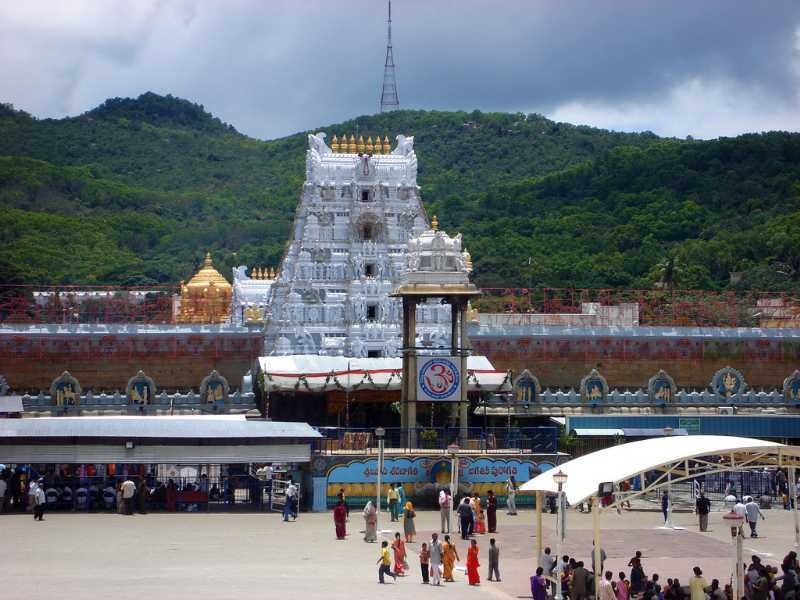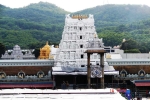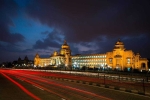Chittoor Tourism
Steeped in religion, devotion and architecture, Chittoor is a place that everyone should visit at least once in their lifetime.
Also blessed with scenic beauty, cascading waterfalls and a beautiful hill station, Chittoor is not a disappointment to the traveller who seeks redemption from the busy metro life. Also known as the Mango City, Chittoor offers myriad varities of heavenly mangoes to please its visitors.
Download Chittoor PDF Guide >
What's Great?
Rich history, culture, tradition, and architecture.
What's not so Great?
Extremely hot and humid in summers.
For Whom
Known for the gorgeous temples in the region, Chittoor has a perfect blend of various elements to satisfy spiritual, religious and artistic tastes of tourists including those of historians.
The Mango City
Located in the Poini River Valley, Chittoor is one of the richest temple towns in South India. Nestled in the hills, with cascading waterfalls, Chittor is home to several divine shrines. Apart from its religious importance, Chittoor is also famous for its multiple varieties of mangoes. A perfect getaway from the hustle bustle of city life, Chittoor has a rich history and legends ranging from the Cholas to the Sultans and thus has something in store for each traveler visiting the city.
History of Chittoor
A contemporary district situated on the banks of Ponnai River has a remarkable history of ancient tales engraved in its beauty. Chittoor Is a Tamil word which means ?a small town? as it was a part of the Tamil constituency ?Thondai Nadu?. The rich historical evidence of this district has been found in Paleolithic tools of Tirupathi, Mesolithic tools in Chinthaparthi and Neolithic tools in Bangarupalem. These are also popular destinations for travellers to understand the emergence of this city and its culture. Komandu Kurumba Prabhu was the first ruler who fortified this place and divided the region into 24 parts. After facing defeat in the 8th and 9th century by the Cholas, Komandu was only left with the eastern region, the rest taken over by Ballal in the 11th century and then by Vijaynagar in the 13th century. The progressive battles left the city with numerous engravings and evidence of its rulers, which are now popular sites for visitors. In later years, Bahmani ruled the region and then conquered by Mughals on 23rd January 1565. In 1713 Marathas and Nizams fought for the region and a treaty was signed between them in 1804 which asked for aid in the return of governance. Few years? later British military took over and ruled until independence in 1947.
One Day Itinerary
Day 1:Start your day off by savouring scrumptious South Indian breakfast. Breakfast cafes or street vendors serve some of the classic Idli/Vada with tangy Sambhar which is a local breakfast dish. Post breakfast, take a cab/bus to Horsely Hills, a picturesque hill station in Chittoor. Sign up for the trek and spend your day strolling around in parks along with making a trip to the zoo. Have lunch and take a cab ride to Kaundinya Wildlife Sanctuary for the evening. Have some coffee and end your day with the evening aarti/prayer ceremony in Sri Venkateshwara Temple. Situated at a height of 853 m, it is a popular holy pilgrimage.
Day 2: Start your second day with a popular Andhra style breakfast in Hotel Sindhu Towers. Take a stroll outside for some savoury street food to compliment your breakfast. Take a bus ride from the nearest bus stop to Nagari Hills. Carry your trekking gear and clothing as its highest cliff is a popular trek circuit. After the climb, you can have a supper and head out for a calm evening in the coastal village of Mogili. Located at a distance of 25 kilometres from Chittoor, it is famous for Mogileeswara temple dedicated to Lord Shiva. The sea winds and a cup of ?kadak chai? is the best combination to relax and end your trip in this cultural city.
Restaurants and Local Food in Chittoor
A staple and tradiotinal meal here, will generally consisit of of a helping of plain rice to go with a variety of gravies and dry meat. Ragi Mudde is also a popular alternate to simple white rice. Other than this there are countless options available if you wish to enjoy local and traditional Andhra cuisine.
View 2 Restaurants in Chittoor >>
Sep-Febis the best time to visit Chittoor
Chittoor experiences hot and dry climate throughout the year. The summers are scorching, and with temperatures soaring up to 40 degrees Celcius, it is not advisable to visit the town in summers. Monsoon is mild, and rainfall is spread over June-September. One can consider visiting the place during this period for the temperatures are mild, and rainfall is not heavy. However, the best time to visit is between September and February when the temperature is moderate and the weather, overall pleasant.
Weather in Chittoor
Loading...
Chittoor in Summer (March-May)
The temperature in summer in Chittoor usually ranges between 24 and 40 degrees Celsius. Summers also experiences maximum humidity. However, occasional showers keep temperature in check in the region.
Chittoor in Monsoon (June -November)
Due to its location, Chittoor experiences monsoons in two phases- South West monsoon in June to September and North East monsoon in October to November. Maximum rainfall is however recorded in the former phase. The temperature in monsoon varies between 20 to 27 degrees Celsius and is comfortable for pilgrims.
Chittoor in Winter (December-February)
The temperature in winters varies between 19 and 25 degrees Celsius. Winters are characterized by windy mornings and cold nights. November to January is the most suitable and peak pilgrim season to visit Chittoor.
Monthly Weather in Chittoor
Month
Avg. Minimum (°C)
Avg. Maximum (°C)
January
18
29
February
18
31
March
23
33
April
25
36
May
25
36
June
25
34
July
24
31
August
24
32
September
23
32
October
22
33
November
20
31
December
18
28
Comments on Chittoor
Post Your Comment


 Horsley Hills
Horsley Hills Kailasakonda Waterfalls
Kailasakonda Waterfalls Market yard-Bangarupalyam and Penumur Mandals and Damalcheruvu
Market yard-Bangarupalyam and Penumur Mandals and Damalcheruvu Kanipakam Vinayaka temple
Kanipakam Vinayaka temple Tirupati
Tirupati Kanchipuram
Kanchipuram Pondicherry
Pondicherry Chennai
Chennai Mahabalipuram
Mahabalipuram Bangalore
Bangalore